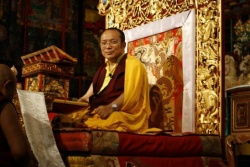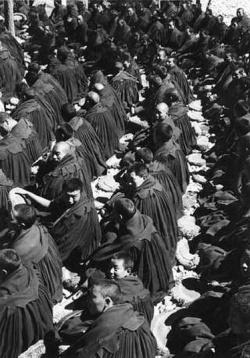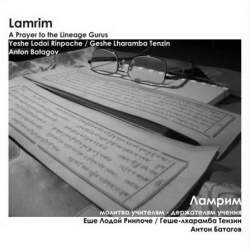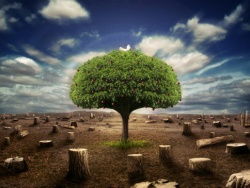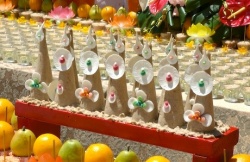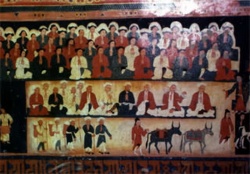Difference between revisions of "Early Tibetan History"
| Line 1: | Line 1: | ||
[[File:Chamgon_Kenting_Tai_Situpa01.jpg|thumb|250px|]] | [[File:Chamgon_Kenting_Tai_Situpa01.jpg|thumb|250px|]] | ||
| + | <poem> | ||
by Chamgon Kenting [[Tai Situpa]] | by Chamgon Kenting [[Tai Situpa]] | ||
[[File:Story 805a.jpg|thumb|250px|]] | [[File:Story 805a.jpg|thumb|250px|]] | ||
| Line 85: | Line 86: | ||
Actually many of the [[temples]] and [[stupas]] were believed to be [[constructed]] through the miraculous [[power]] of the [[king]]. Of course he had tremendous secular [[power]] as well, but a [[person]] who can unite such a big area with such a wild {{Wiki|civilization}} at the age of thirteen has got to be pretty able. So with [[spiritual]] [[power]] as well as temporal [[power]], all this might, I think he managed to establish this. | Actually many of the [[temples]] and [[stupas]] were believed to be [[constructed]] through the miraculous [[power]] of the [[king]]. Of course he had tremendous secular [[power]] as well, but a [[person]] who can unite such a big area with such a wild {{Wiki|civilization}} at the age of thirteen has got to be pretty able. So with [[spiritual]] [[power]] as well as temporal [[power]], all this might, I think he managed to establish this. | ||
| + | </poem> | ||
{{R}} | {{R}} | ||
[http://ktcdallas.org/2013/03/01/tibetan-buddhist-history-chamgon-kenting-tai-situpa/ ktcdallas.org] | [http://ktcdallas.org/2013/03/01/tibetan-buddhist-history-chamgon-kenting-tai-situpa/ ktcdallas.org] | ||
[[Category:Tibetan Buddhist History]] | [[Category:Tibetan Buddhist History]] | ||
Revision as of 04:53, 30 October 2013
by Chamgon Kenting Tai Situpa
Often we will get questions on where to find a simple historical overview of Tibetan Buddhist History that includes all the lineages. This article, transcript of a talk given by Chamgon Kenting Tai Situpa, was originally published in the New Zealand Dharma Magazine Thar Lam, whose editor, Sonam Rinchen, gave KTC Dallas permission to publish the article on our web site to make it widely available.
As requested I will go through the Buddhist history of Tibet. We have three types of history in Tibet with many alterations: the history of the kings and the country; the dharma history (Buddhist history) in India from Buddha until now; and the Buddhist history of Tibet. Of course they are not in conflict with each other, but emphasize specific areas.
What I am going to share with you here is a very brief form of the Buddhist history of Tibet, not of India, and it will involve some of the history of the kings and the country also, because the main patrons of dharma in Tibet were the Tibetan kings. So they will come into the picture once in a while.
Originally Tibet was a lake; it was an ocean a long time ago-we are talking millions of years ago. Then, in the ocean an island developed, and on the island two kinds of creatures lived: one was a monkey and the other was a cannibal. The female cannibal and the male monkey got involved and six children were born from them.
They are known as Miwu Dongdruk. On the Tibetan national flag there are six rays of the sun, which represent them. The six children had individual characteristics: one was very happy and proud like a god; one was very jealous like an asura (demi-god); one was very passionate like a human; one was quite stupid like an animal; one was very stingy like a hungry ghost, and; one was very angry like a hell being. So each of the six children had their own characteristics, and that way their offspring also had their own characteristics.
Now this went on and on for a long time and the population became quite sizeable; then the lake vanished and the land developed. So the Tibetan land is quite new compared to many other lands in this world. On very high mountain tops in Tibet you can find fossils of sea creatures, and if you break some of the stones on avery high mountain you may find shells, fish, and all kinds of things from the bottom of the sea. This way Tibet is quite recent in the galactic age, but of course in human age it is very old, we are talking about millions of years.
Then from these descendents many small groups and tribes developed. One place, which is considered the first village of Tibet, is in the area of Kongpo, a subtropical part of Tibet. There is a valley of Brahmaputra, which flows from east to west and has lots of flora and fauna which is not found in northern or the western parts of Tibet. In this valley was the first valley, which was known as ‘Nose of the Monkey’. Maybe it was described like that due to the shape of the mountain on which the village was established. In Tibetan it is called Kongpo Trelna. Trelna means nose. Most of the people in that area were hunters and also cultivated the land.
At that time there was an Indian prince from the race or the tribe of Litsambi. One time he was wandering; why he was wandering was not very clear. Maybe he just left everything and wandered, or maybe there were too many princes in the family and he did not want to have competition with them, or maybe he did something wrong and he got kicked out from the family. In those days they did that, they called it banishment. ( Editor’s note: The child’s feet and hands were webbed like a swan and his eyelids closed upwards like a bird’s. His father, thinking that his son must be of non-human origin, declared that he should be banished. As soon as the boy grew up a little he was sent away. – From The Words of My Perfect Teacher)
So this prince was wandering in the forest and some hunters found him, but he was very different from them. He was very handsome and civilized, very graceful, an unusual human being. They were immediately taken by him and asked, “Where do you come from?” They did not speak each other’s language so he pointed to the sky. So the people thought he came from the sky, that he was a god or something. Then they really respected him and immediately made a kind of carrying chair out of wood and carried him on their shoulders to the village. They made him the king of that village and he was known as Nyatri Tsenpo. Tsenpo means king, nyawa means neck or shoulder and tri means throne; so the king who was carried on the shoulders of the people, their shoulders were the throne. He was supposed to be the first Tibetan king.
Lhari Chanror was the name of the place where he was found. Lha means god, ri means mountain, so he was found on the Mountain of the Gods. From him, after twenty-six generations, there was a king whose name was Lha Thothori Nyantsen. He built the first castle in Tibet, known as Yumpu Lhakar, which is a little bit above Lhasa, near the airport. If you fly to Lhasa then from the airplane you can see it. To go there of course you have to take a little turn. It is on top of a mountain, a very small castle. But that was the first, the biggest castle built by Lha Thothori Nyantsen, the twenty-sixth king after Nyatri Tsenpo.
After he had completed that castle – the original castle was destroyed by the Chinese during the Cultural Revolution. The Cultural Revolution was such that the Chinese somehow instigated Tibetans so that Chinese and Tibetans went together and destroyed things. So actually, mainly, it was physically done by our own people, it wasn’t only the Chinese; it was the Tibetans who were following the Chinese. They also destroyed things in my area. My monastery is quite far away from Yumpu Lhakar; on horseback it takes one and half months to get there. They destroyed Yumpu Lhakar before or during the Cultural Revolution. But now it is rebuilt in the same shape because there were lots of photographs of the original one, but of course it is not the same. Many Europeans who went to India, and some Indians actually, also some Russians and Czechoslovakians who went to Tibet, had lots of photographic records. So this is very well known and impressive, a very beautiful castle with a tower.
Anyway, one day Lha Thothori Nyantsen was in the tower praying and his castle was then totally covered with lights, rainbows and clouds, and a miraculous thing happened. In the midst of this mysterious display he ended up with a box in his hands. He was on top of the castle praying, and suddenly a box appeared in his hands, just like that, out of thin air.
When the box was opened, inside there was a sutra known as Samatok Kopa, Samatok Kopeto (Sutra Designed like a Jewel Chest), and one called Pangon Chag-gyapa (Sutra of a Hundred Invocations and Prostrations), and then Cittamani (wish fulfilling jewel), that is the mantra OM MANI PEME HUNG, and a little golden stupa. So these were all found in the box in his hands.
So Lha Thothori Nyantsen, on top ofYumpu Lhakar, found these. That is considered, historically, the first time Buddhism came to Tibet, miraculously. Then in a dream he saw that in the future, five generations from him, they would know the meaning of the content of these objects: the stupa, the texts and the mantra.
The fourth generation after Lha Thothori Nyantsen was a Tibetan king called Namri Songtsen. His queen was Deza Okar and they had a son, Songtsen Gampo, who was the fifth generation from Lha Thothori Nyantsen.
When Songtsen Gampo (617-698 A.D.) was thirteen years old he became the king of Tibet. Through his might and wisdom and power he united all of Tibet and is known as the unifier of all of Tibet. Tibet then was two and a half million square kilometers, a huge place, occupied withlittle kingdoms and tribes and Songsten Gampo united that after he was thirteen years old. At that time he had a very special minister, Gonzo Gar, who was a genius. The king sent this minister to Nepal and a Nepali princess, Ozer Korza, was brought to Tibet to be queen for Songsten Gampo. The king also sent the minister to China, and from there, a Chinese princess, Ungchen Kongcho, was also brought to Tibet to become his queen.
So he had two Queens, a Nepalese princess and a Chinese princess. The Nepalese princess brought her favourite Buddha from Nepal and the Chinese princess brought her favourite Buddha from China. The Buddha brought from China was actually the personal Buddha image worshipped and commissioned by the king Ashoka. It is the most important religious relic in all Tibet, we call it Jow Rinpoche. It is still in Lhasa, even today. During the Cultural Revolution, or before, it was very badly damaged, but it survived, and it is enshrined at Jokhang temple. It is worshipped by all Tibetans and many other Buddhists who go to Tibet. The Jowo was originally from India, it belonged to king Ashoka, then it went to China, where it was the favourite Buddha of the princess.
When the emperor, her father, told her, “You have to go and marry the Tibetan king,” she said, I will only go if I can take my Buddha with me.” It is a big Buddha statue, so many people had to carry it on a palanquin all the way from China to Lhasa. It was a big task.
[[
Songtsen Gampo’s]] minister, Gonpo Gar, had a son in Kham, East Tibet, and he was our king. Kham is where I come from. Where I was the Rajguru is called Derge, and the first king of Derge was the son of this minister. The last king, the descendent who died in 1992 or 1993, was the fiftieth in the dynasty, a very long dynasty from the time of Gonpo Gar.
So the minister Gonpo Gar brought two princesses to Tibet, the king Songtsen Gampo married them both, and they brought two precious Buddhas to Tibet. At that time Tibetans did not have a complete form of writing, a script, but of course historians are such that many of them say there was Tibetan writing, there was Tibetan civilization and there were Tibetan villages before. There are lots of disagreements among Tibetan historians but I am going with the main stream. These things are popping up these days, but when I was a teenager and learned about Buddhist history, I did not hear about those things, but I hear about these things today; one or two decades pass and lots of new things come. They even have scriptures and say that it is Tibetans’ original writing! But I have no clue what those writings really mean and I don’t know how to read them.
There is a common historical belief that there was a person called Trinmey Abu, who had a son who was sent to India and learned Sanskrit from a very learned Sanskrit master there, Lha Rigpe Senge. Lha means god, rigpa means intelligence, senge means lion. I don’t know what his name is in Sanskrit; but he was a very learned Indian pandita and in Tibetan his name is Lha Rigpe Senge.
So this son was sent to Kashmir, a part of Tibet, to Katshe-Katshe means Kashmir-and he was given the name Sambhota. Bhutia, bhota means Tibetan. Sam means good. Thonmi was his family name, so Thonmi Sambhota. Then he came back and he created the Tibetan alphabet which has thirty letters and four vowels; i, u, e and o.
That was the beginning of Tibetan writing, which was based on Sanskrit. In Tibetan we have ka, kha, ga, nga cha, ch’a, ja, nya; ra, tha, da, na; pa, pha, ba, ma; tsa, tsha, dza, wa; zsha, za, d, ya; ra, la, sha, sa; ha, a; as the alphabet.
In Sanskrit they have ka, kha, ga, ghaa, nga; ca, cha, ja, jaa, nya; ta, tha, da, daa, na. So in Tibetan we don’t have those extra things. Thonmi Sambhota did it that way because it had to match the Tibetan language. The Tibetan language already existed, but not in a written form; a complete efficient written Tibetan language did not exist, that is how it is expressed, historically. That means there must have been some means of recording things but not with complete grammar etc.
So Thonmi Sambhota added grammar and all the other necessary things for literature. In total, seven stages of grammar were made, but now most Tibetans only use two of them. That is sufficient for the functioning of Tibetan literature right now.
The other five of them are somehow included in these two, or were not that important. At that time maybe it was made that way because it was fresh from Sanskrit. Therefore, many of the rules of Sanskrit he tried to apply to Tibetan language.But later, over the centuries, it was not that necessary and not that useful, so it disappeared. So now we are dealing with two, we learn two of them. The other five are supposed to have disappeared. It is general knowledge for all Tibetans that the text on grammar written by the eighth Tai Situpa over 200 years ago is the most famous and most comprehensive text on grammar in the Tibetan language. It is called the Rosary of Pearls. It is supposed to have the resonance of all the five other grammars in it because the eighth Tai Situpa was so good in grammar that somehow he rediscovered them through the literature. Anyway, Thonmi Sambhota created the Tibetan script.
Now this king, Songtsen Gampo, who conquered all of Tibet and greater Tibet, he developed in greater Tibet which he occupied and where he established his authority – he created laws based on Buddhism. There were laws to award those who conducted the ten virtues and laws to punish those who conducted the ten non-virtues. So the law was based on the ten virtues and ten non-virtues.
The ten virtues are:
1. giving, being generous;
2. being physically moral, no misconduct and;
3. saving lives. These three are virtues of the body.
4. Telling the truth;
5. bringing people together instead of slandering;
6. saying kind words and;
7. having meaningful conversations.
These are the four rules of speech. Then the three positive activities of the mind are:
8. Appreciating what other people have, saying that it is good and not wanting it for yourself;
9. being kind to others, having a kind heart towards others and;
10. having the right view; right view means the philosophy of karma, the philosophy of the ultimate… that everyone is good, those sort of basic philosophies, correct understanding.
Those are the ten virtues. The ten non-virtues are the opposites to those: killing, stealing, misconduct, lying, slandering etc.
So the king punished those who engaged in the ten non-virtues and rewarded those who engaged in the ten virtues. That was his rule, his law throughout Tibet, and all the rules and laws are based on that. For example, in the kingdom where I am from, Derge, there is a constitution which ends: “If you don’t feed your dog it is an offence of the law.” That is the last law in the constitution. That way law and order was established.
Also both the king and queen visited temples and villages according to very important principles of the [[Vastu [shastra]] (Geomancy). Tibetans call it shastje. Tibet is like a female cannibal on her back and on all the spots… for example, the right shoulder, left shoulder, right leg and left leg, they built four temples on those places that are known as lu shi temples. Then the right elbow, left elbow, right knee, left knee, they built four thadul temples on those places. Then the right palm, left palm (in Derge), the right sole of the foot, the left sole of the foot (Bumtang in Bhutan), are the yangdul temples. These are the twelve main temples that were built on the different spots of this female cannibal lying on her back; that is how the greater Tibetan kingdom looks.
Then where the heart is was a small lake, which was covered, so the lake was made a big plain and there the main temples of Jokhang and Ramoche were built, the main temples of Lhasa. It is known as the lake of milk field, field of milk, O tang tso.
Together with that there were 108 temples and 108 stupas built all over the greater Tibet in important spots. That is why, without any doubt, I believe the ancient civilization together with the precious teachings of Buddha and that lineage was preserved in Tibet, even with all the terrible political upheaval, such as the Cultural Revolution. All these terrible things happened, but still, they really could not totally destroy it. Even the cultural heritage and lineage survives today, which I think has a lot to do with this, how Buddhism was established there.
Actually many of the temples and stupas were believed to be constructed through the miraculous power of the king. Of course he had tremendous secular power as well, but a person who can unite such a big area with such a wild civilization at the age of thirteen has got to be pretty able. So with spiritual power as well as temporal power, all this might, I think he managed to establish this.
